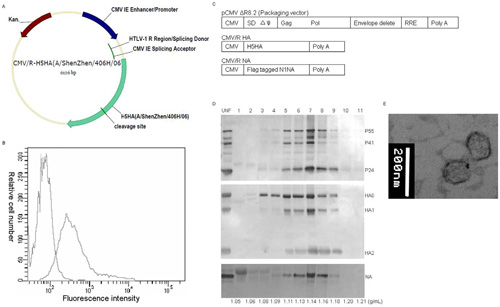A team of researchers, led by Paul Zhou, at Institut Pasteur of Shanghai, Chinese Academy of Sciences, found superior neutralizing antibody response and protection in mice vaccinated with heterologous DNA prime and virus like particle (VLP) boost against HPAI H5N1 virus. The results of this study demonstrate that superior neutralizing antibody response and protection in mice vaccinated with heterologous DNA prime and VLP boost against HPAI H5N1 virus, and also provide strong support for clinical evaluation of heterologous DNA-VLP prime-boost strategy as a public health intervention against a possible H5N1 pandemic.
Vaccination is considered to be a main tool that can be used to effectively reduce the morbidity, mortality, and economic effects of influenza epidemics. Since the replication of HAPI H5N1 virus can kill the chicken embryos, traditional production method of influenza vaccine is restricted. Many new vaccine candidates were tested, such as DNA plasmid and virus-like particle (VLP) vaccines.
In this research, DNA plasmid and virus-like particle (VLP) vaccines were first combined into a heterologous prime-boost strategy against HPAI H5N1 viruses. And the neutralizing antibody responses and immune protection elicited with heterologous DNA-VLP, homologous DNA-DNA and VLP-VLP prime-boost strategies against HPAI H5N1 viruses in mice were compared. DNA plasmid encoding H5HA was constructed and VLP expressing the same H5HA and N1NAwere generated. By usinga HA/NA pseudotype-based neutralization (PN) assay previously developed in the lab, the researchers demonstrated that DNA-VLP elicits the highest neutralizing antibody titers among the three prime-boost strategies; whereas DNA-DNA elicits higher neutralizing antibody titers than VLP-VLP. In addition, only DNA-VLP and DNA-DNA, but not VLP-VLP, protected mice from death caused by 1,000 MLD50 of homologous H5N1 challenge. Finally, only DNA-VLP protected half of the mice from death caused by 1,000 MLD50 of heterologous H5N1 challenge.
This research was published online in PLoS ONE on January 28th, 2011.
This work was supported by research grants from the French Ministry of Health, National Natural Science Foundation of China(NSFC), National Science and Technology Major Project of the Ministry of Science and Technology of China and the Li Ka-Shing Foundation of Hong Kong.
Vaccination is considered to be a main tool that can be used to effectively reduce the morbidity, mortality, and economic effects of influenza epidemics. Since the replication of HAPI H5N1 virus can kill the chicken embryos, traditional production method of influenza vaccine is restricted. Many new vaccine candidates were tested, such as DNA plasmid and virus-like particle (VLP) vaccines.
In this research, DNA plasmid and virus-like particle (VLP) vaccines were first combined into a heterologous prime-boost strategy against HPAI H5N1 viruses. And the neutralizing antibody responses and immune protection elicited with heterologous DNA-VLP, homologous DNA-DNA and VLP-VLP prime-boost strategies against HPAI H5N1 viruses in mice were compared. DNA plasmid encoding H5HA was constructed and VLP expressing the same H5HA and N1NAwere generated. By usinga HA/NA pseudotype-based neutralization (PN) assay previously developed in the lab, the researchers demonstrated that DNA-VLP elicits the highest neutralizing antibody titers among the three prime-boost strategies; whereas DNA-DNA elicits higher neutralizing antibody titers than VLP-VLP. In addition, only DNA-VLP and DNA-DNA, but not VLP-VLP, protected mice from death caused by 1,000 MLD50 of homologous H5N1 challenge. Finally, only DNA-VLP protected half of the mice from death caused by 1,000 MLD50 of heterologous H5N1 challenge.
This research was published online in PLoS ONE on January 28th, 2011.
This work was supported by research grants from the French Ministry of Health, National Natural Science Foundation of China(NSFC), National Science and Technology Major Project of the Ministry of Science and Technology of China and the Li Ka-Shing Foundation of Hong Kong.

Characterization of immunogens ( Image by ZHOU Paul's Group )

